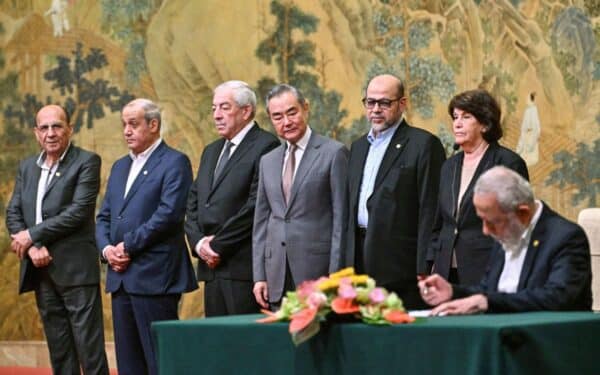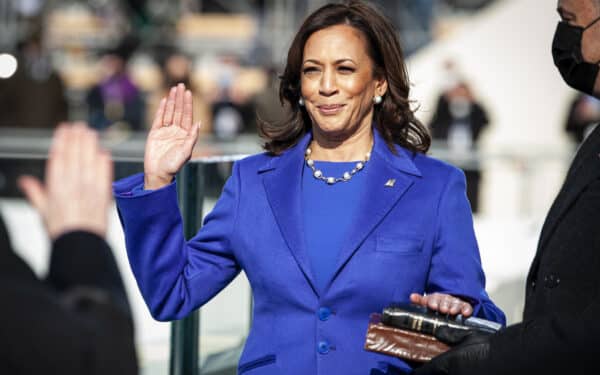Writing in his diaries in 1953, Cecil Beaton reflected on what had been a hellish day photographing the Queen’s coronation. “The bulk of my pictures had been a smash and grab affair,” he admitted. “I couldn’t imagine they would be successful. Not only was I depressed, but rather alarmed. If the results weren’t sensationally good, the Press would attack me bitterly for having failed with such a fine opportunity. […] Had I misused the trust?”
We know now that he had not misused the trust. Far from it. He had, in fact, produced a photograph that remains to this day one of the finest portraits, certainly of the Queen, but of any world leader.
Beaton’s timeless portrait frames the Queen as the focal point of centuries of tradition. The picture is dominated at the bottom by the strong dark triangle of her gown, directing the eye towards the figure on the throne. Yet the figure of the Queen is slightly off-centre, creating tension with the objects at the very centre of the frame. The monarch is in a subservient role to the instruments of state – the orb and sceptre – but also to history, which wraps itself around her in the form of the painted backdrop of Westminster Abbey.
This is no doubt a partial reading of a complicated photograph and that complication is why Beaton transcends the mere description of “photographer” to have become an artist in his own right. Seventy-odd years later, however, the coronation of King Charles III culminated in his official photograph by the safe (but boring) lens of Hugo Burnand, a picture that barely transcends the snapshot. What a dowdy affair it is. To say it’s very much “on the nose” is to understate the effect it has. To summarise it would be to repeat the Private Eye front page from last week: “Man in hat sits on chair”. The portrait really is that ordinary.
And yet perhaps the photograph is very much a product of its time. It conveys a general sense of the mundane that pervaded the coronation. It embodies the very paradox that this royal family faces in these increasingly secular and austere times. To speak of the scaled-down monarchy (as I have myself done repeatedly) leads to the inevitable realisation that monarchy cannot exist in a vacuum of pomp. The weekend’s ceremony was not that of a young Queen coming to the throne at a time of national rebuilding and, indeed, the restoration of Europe after the most devastating war in human history. This was a man in his seventies who seemed burdened by the duties that had fallen to him when most people are well into their retirement. More strikingly: he looked every one of his years.
The world is also very different from 1953. No monarch will have ever felt this exposed, watched over in real-time by a huge swathe of humanity. Watching the ceremony on a big screen, broadcast by the BBC in high definition, one sensed something was missing or, rather, something was too present. What was missing was the sense of something missing. Footage of the last coronation was a muzzy affair. The cameras were never quite close enough. It ensured that the whole proceeding was governed by a sense of mystery. For all those years we’ve wondered what a coronation would really look like if only the cameras could have got in closer. If only we could see more.
Except it turns out that is precisely what we didn’t need. Or, rather, it’s not what the monarchy needs. The cameras inside the Abbey saw everything. We saw every grimace – “oh, he’s in one of his moods” was probably uttered toward every TV screen in the land – and every hesitation. The only thing we often didn’t see was the face of Prince Harry, hidden behind a conveniently tall feather on Princess Anne’s hat. Perhaps the feather was working on behalf of Netflix who now own the rights to Harry’s face and its reactions.
This sense of knowing too much was compounded by the lipreaders shamefully reporting what was said in the carriages. Nobody has any privacy in this 24/7 world. You don’t need to be a monarchist to think that a King’s privacy should be respected given that he has so little privacy at these events. It’s this culture of nosey intrusion that means that footballers have to cover their mouths when talking to each other on the pitch. How soon before we all start to adopt the same policy in public? It was all as depressing as Twitter, alive with constant sniping at every tradition. The only person to emerge with any dignity from the whole affair had been dead nearly 300 years as a new generation of music fans realised that G.F. Handel’s “Zardok the Priest” is a proper “thumper” of a tune.
What was also depressing was the arrest of members of the public on the morning of the coronation. It’s important to note that they claim not to be anti-monarchists but pro-republican, and their arrest has only helped their cause. My own republican sentiments have never been that strong. As an atheist, I can’t square the circle of anybody appointed to rule by God. The notion of a royal family also seems cruel. Imposing a sense of duty on a child seems inherently wrong. Yet all these arguments pale compared with bigger issues. I’m republican but not so committed to the cause that I think much about it… until the police start to arrest peaceful protestors far away from the ceremony and Archbishops start to ask people to take oaths in a “homage of the people”. Then I discover I’m a lot more republican than I previously suspected.
That the Palace responded quickly to the nonsense coming out of Lambeth Palace was one of the few goods to come out of the weekend’s events and it would be hoped that the King expresses strong opinions about the arrests. We might not be at the tipping point for the monarchy but there is nothing more certain to hasten it than an increasingly draconian government using ill-considered legislation to stifle free speech. The subsequent contribution of Lee Anderson was as unwelcome as it was crass. Suddenly, rather than merely observing a spectacle, we were witnessing things which impact individual lives and impact our lives. So much for the monarchy being above politics. The monarchy was suddenly deeply immersed in politics. It was not a good look.
And that was the ultimate revelation about this coronation. These state occasions need to be experienced from a distance where you see the totality of the effect and not the effect the totality of the spectacle was having on one man. It returns us to Beaton’s photograph of the Queen, a picture that has a painterly quality in part because elements of the photograph are a painting. Yet the effect isn’t an attempt to create the illusion of a Westminster Abbey that isn’t there. It grounds the Queen in the history of painting itself. Photography isn’t always about preserving every detail. It’s sometimes about obfuscation. Sometimes it’s about allowing shadows to deepen or light to blow out the detail. The same might be said about monarchy: which requires as much absence as presence, more light touch than heavy. Charles’s coronation and the subsequent portraits did quite the opposite. The colours were too vibrant, the details too sharp, and the politics too pronounced. We saw every crease and wrinkle so that gowns didn’t look like gowns but pieces of specific material. We saw every pore of the very human man now sitting on the throne. We saw, in effect, too much. There was no magic. Merely stitching, buttons, and frowns.
@DavidWaywell
Write to us with your comments to be considered for publication at letters@reaction.life




